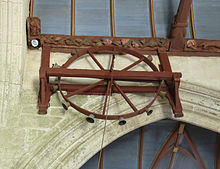Bell wheel
A bell wheel (French roue à carillons ; Spanish rueda de campanas ) is a signaling instrument usually attached to the door to the sacristy with mostly eight or twelve bells that were struck by the altar boy or the priest before the beginning of the mass when entering the chancel. Instead of altar bells , they could also be rung during the change .
Description and attachment
The usually eight-spoke bell wheel is mounted vertically on a horizontal axis. Originally, the ringing, which was attached at shoulder height and usually consisted of eight bells of equal size, was probably set in motion by turning the wheel by hand; in later times it was usually fastened above a door and operated by pulling a pendulum cord or a chain with a spring mechanism.
history
The bell wheels, which are widespread in large parts of Europe, have probably only been known since the end of the Middle Ages; we know that they were made for churches in the 18th century. Their function, however, was increasingly taken over by the altar bells or bells. Bell wheels were sometimes used as a ringing device in castles or in noble private homes. Bell wheels have also been used as children's toys since the 19th or 20th century.
See also
literature
- Veit Heller: The bell wheel in iconography and practice. In: Iconographic evidence of musical instruments in Central Europe. Michaelstein Monastery Foundation 2000, ISBN 978-3-89512-109-8 , pp. 37–58.
Web links
- Bell wheel. In: The large art dictionary by PW Hartmann
- Bell wheel and carillon. In: Reallexicon of German Antiquities, 1885
- Bell wheel in motion Flickr photo
- Otras photos rueda de campanas Catedral de El Salvador. Bell wheel in the cathedral of the Spanish city of Orihuela, photos

